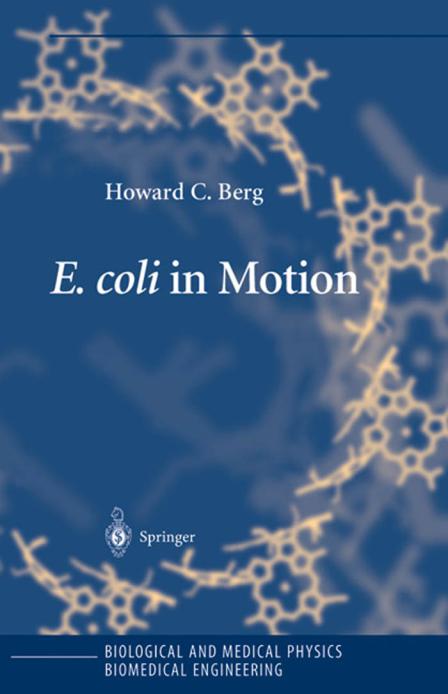
- •ISBN 0-387-00888-8
- •Series Preface
- •Preface
- •Contents
- •Appendix. Parts Lists
- •Index
- •1. Why E. coli?
- •2. Larger Organisms
- •3. Cell Populations
- •4. Individual Cells
- •5. Flagellar Motion
- •6. Physical Constraints
- •7. Optimal Control
- •8. Cellular Hardware
- •9. Behavioral Hardware
- •11. Gain Paradox
- •12. Rotary Motor
- •13. Epilogue
- •Index


BIOLOGICAL AND MEDICAL PHYSICS
BIOMEDICAL ENGINEERING
Springer
New York
Berlin
Heidelberg
Hong Kong
London
Milan
Paris
Tokyo

BIOLOGICAL AND MEDICAL PHYSICS
BIOMEDICAL ENGINEERING
The fields of biological and medical physics and biomedical engineering are broad, multidisciplinary and dynamic. They lie at the crossroads of frontier research in physics, biology, chemistry, and medicine. The Biological & Medical Physics/Biomedical Engineering Series is intended to be comprehensive, covering a broad range of topics important to the study of the physical, chemical and biological sciences. Its goal is to provide scientists and engineers with textbooks, monographs, and reference works to address the growing need for information.
Editor-in-Chief:
Elias Greenbaum, Oak Ridge National Laboratory, Oak Ridge, Tennessee, USA
Editorial Board:
Masuo Aizawa, Department of Bioengineering, Tokyo Institute of Technology, Yokohama, Japan
Norma Allewell, Department of Biochemistry, University of Minnesota, St. Paul, Minnesota, USA
Olaf S. Andersen, Department of Physiology, Biophysics and Molecular Medicine, Cornell University, New York, USA
Robert H. Austin, Department of Physics, Princeton University, Princeton, New Jersey, USA
James Barber, Department of Biochemistry, Imperial College of Science, Technology and Medicine, London, England
Howard C. Berg, Department of Molecular and Cellular Biology, Harvard University, Cambridge, Massachusetts, USA
Victor Bloomfield, Department of Biochemistry, University of Minnesota, St. Paul, Minnesota, USA
Robert Callender, Department of Biochemistry, Albert Einstein College of Medicine, Bronx, New York, USA
Britton Chance, Department of Biochemistry and Biophysics, University of Pennsylvania, Philadelphia, Pennsylvania, USA
Steven Chu, Department of Physics, Stanford University, Stanford, California, USA
Louis J. DeFelice, Department of Pharmacology, Vanderbilt University, Nashville, Tennessee, USA
Johann Deisenhofer, Howard Hughes Medical Institute, The University of Texas, Dallas, Texas, USA
Continued on page 133 after Index

Howard C. Berg
E. coli in Motion
With 42 Figures, 1 in Full Color
1 3
Howard C. Berg
Department of Molecular and Cellular Biology Harvard University
Cambridge, MA 02138 USA hberg@biosun.harvard.edu
Library of Congress Cataloging-in-Publication Data
Berg, Howard C., 1934–
E.coli in motion / Howard C. Berg.
p. ; cm.—(Biological and medical physics biomedical engineering) Includes bibliographical references and index.
ISBN 0-387-00888-8 (hc. : alk. paper)
1. Escherichia coli. 2. Microorganisms–Motility. I. Title. II. Series. [DNLM: 1. Escherichia coli—pathogenicity. QW 138.5.E8 B493e 2003]
QR82.E6B47 2003 |
|
579.3¢42—dc21 |
2003045491 |
ISBN 0-387-00888-8 |
Printed on acid-free paper. |
© 2004 Springer-Verlag New York, Inc.
All rights reserved. This work may not be translated or copied in whole or in part without the written permission of the publisher (Springer-Verlag New York, Inc., 175 Fifth Avenue, New York, NY 10010, USA), except for brief excerpts in connection with reviews or scholarly analysis. Use in connection with any form of information storage and retrieval, electronic adaptation, computer software, or by similar or dissimilar methodology now known or hereafter developed is forbidden.The use in this publication of trade names, trademarks, service marks, and similar terms, even if they are not identified as such, is not to be taken as an expression of opinion as to whether or not they are subject to proprietary rights.
Printed in the United States of America.
9 8 7 6 5 4 3 2 1 |
SPIN 10922125 |
www.springer-ny.com |
|
Springer-Verlag New York Berlin Heidelberg
A member of BertelsmannSpringer Science+Business Media GmbH
Series Preface
The fields of biological and medical physics and biomedical engineering are broad, multidisciplinary and dynamic. They lie at the crossroads of frontier research in physics, biology, chemistry, and medicine. The Biological & Medical Physics/Biomedical Engineering Series is intended to be comprehensive, covering a broad range of topics important to the study of the physical, chemical and biological sciences. Its goal is to provide scientists and engineers with textbooks, monographs, and reference works to address the growing need for information.
Books in the series emphasize established and emergent areas of science including molecular, membrane, and mathematical biophysics; photosynthetic energy harvesting and conversion; information processing; physical principles of genetics; sensory communications; automata networks, neural networks, and cellular automata. Equally important will be coverage of applied aspects of biological and medical physics and biomedical engineering such as molecular electronic components and devices, biosensors, medicine, imaging, physical principles of renewable energy production, advanced prostheses, and environmental control and engineering.
Elias Greenbaum
Oak Ridge, TN
v
This page intentionally left blank
Preface
Most bacteria are small, about one micrometer in diameter: ten thousand cells laid out side by side span the width of one’s finger. Nevertheless, many species are motile. They swim using propellers (called flagella) that extend out into the external medium or, in the case of spirochetes, that rotate within the cell envelope. One marine bacterium appears to use submicroscopic external oars. Other common bacteria, equipped with large numbers of flagella, swarm rapidly over surfaces. Some bacteria glide over surfaces by extending and retracting thin filaments (called pili) that stick to the substratum at their distal ends, a kind of fly casting. Others move particles linked to the substratum along their outer membranes, by a mechanism as yet unknown. Bacteria of all kinds respond to changes in their environment, for example, to changes in temperature, light intensity, or chemical composition. In short, they move in a purposeful manner.
I have been interested in this world for more than 30 years. When I began, more was known about the genetics and biochemistry of the bacterium Escherichia coli than of any other freeliving thing. So that has been the organism of choice.The emphasis has been on the responses of this organism to chemical stimuli: chemotaxis. Early work on the motile behavior of bacteria had been done with larger species, more easily seen in the light microscope, so these also are of interest.
How, exactly, does E. coli behave? What is the machinery that makes this behavior possible? How is the construction of this machinery programmed? How does this machinery work? And finally, what remains to be discovered?
Since E. coli is microscopic and lives in an aqueous environment, the physical constraints that it has had to master are very different from those that we encounter. For example, E. coli knows nothing about inertia, only about viscous drag: it cannot coast. It knows nothing about transport by bulk flow, only about diffusion;
vii
viii Preface
as we will see, it can go where the grass is greener, but it has to wait for its dinner. So the methods that its cells use to move and sample their environment are strange to us. This is part of E. coli’s charm.
This book is designed for the scientist or engineer, not trained in microbiology, who would like to learn more about living machines. However, it also should be accessible to the educated layman and of interest to the expert. I try to build on first principles. However, if you are overwhelmed by the facts that appear in a given chapter, please read on: the figures might suffice. References are given as entrée to the literature and a tribute to those who have done the work.
My own research has been supported by the Research Corporation, the U.S. National Science Foundation, the U.S. National Institutes of Health, and the Rowland Institute for Science. Much of the writing was done while a Fellow of the John Simon Guggenheim Foundation. Space for thought was provided by the Lorentz Institute, Leiden.
A large number of capable people have contributed to the body of knowledge to be described here: molecular geneticists, biochemists, microbial physiologists, physicists. Some, no doubt, will disagree with my emphasis. I can claim only a small part of this work as my own, built on the labor of students, postdocs, and other colleagues. The real hero is E. coli. If nothing else, I hope that this book will convince you that E. coli demands our admiration and respect.
HOWARD C. BERG
Cambridge, Massachusetts
August 2003
